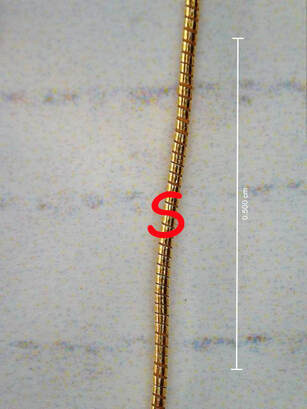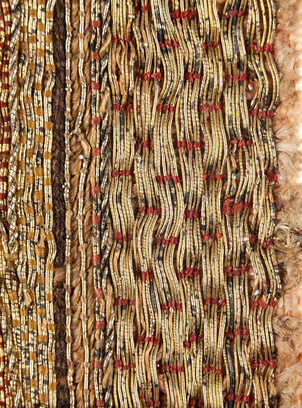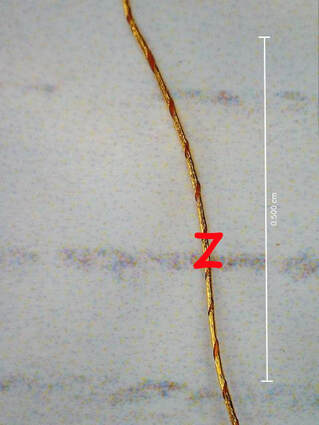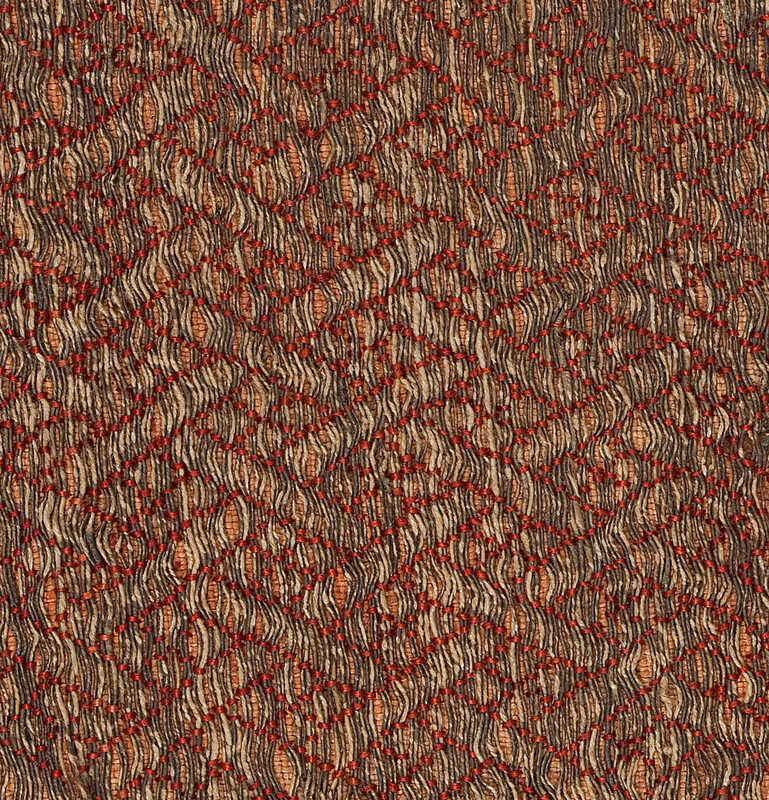|
Last week's simple experiments told me a lot about the anatomy of the modern gold threads we use in our embroideries. But how does this compare to the gold threads that were being used in the medieval period? When you are familiar with goldwork embroidery, you probably know that there is a myriad of different gold threads available nowadays. This plethora of forms and shapes is a relatively new invention. Before the end of the Middle Ages, your stash would have looked rather clear and orderly. If, for instance, you lived in England, France or the Low Countries, your threads were probably made of a gilded silver foil wrapped around a silken core. However, if you lived in Germany, your thread was probably made of a strip of gilded silver glued onto a membrane (animal gut) and wrapped around a linen core. Membrane threads (usually with a silken core) were also used in the weaving of luxurious silk fabrics. But probably not in embroideries in England, France and the Low Countries. Sorry for the use of the word "probably" so frequently. Unfortunately, the makeup of the metal threads used in medieval embroideries is not routinely stated in the literature. And researchers that analyse metal threads do usually not differentiate between thread samples taken from an embroidery and those taken from a woven textile. However, I have a gut feeling that there might be a difference. After all, the technique and motions are quite different. And whilst you can use many threads for both embroidery and weaving, some work much better than others. I do not have many answers yet, as I am currently in the process of untangling the gold threads from the published data. What I can say is that the twist of the foil around the core in these medieval passing threads seems to be S-twisted. This is also the case in the modern passing threads I took apart last week. However, seeing the passing thread under the digital microscope made me realise that the width of the metal foil is very small (especially when compared to the Japanese threads). How does this compare to medieval gold threads? The number of wrappings per centimetre is hardly ever stated :(. When you look at the close-up of ABM 2107f held at the Catharijne Convent, at first glance, it does seem to correspond well with the modern passing thread. However, if you zoom in and measure the ratio of the width of the gold thread and the width of the gold foil, the gold foil is about twice as wide as the width of the thread. For the modern passing thread, this ratio is about 1:1. This means that the strips of gold foil in a modern passing thread are thinner and that there are more wraps per centimetre. Is this difference important? Does it make for a different embroidery experience? And how will we ever be able to tell? What also struck me during the second run of my medieval goldwork course was that we use modern passing threads on the two samples that were originally stitched with membrane gold. It works, but would the use of a modern Japanese thread be closer to the medieval membrane thread? Is the paper substrate comparable with the animal gut substrate when it comes to the behaviour of the thread? How heavily gilded were the original medieval membrane threads? Do they compare better with non-tarnish Japanese threads or with the real deal in which a high gold content is used? And what about the core? There are some membrane threads used in medieval embroidery that do have a silken core. But the majority is linen. And from the pictures above you can tell that the modern Japanese threads are Z-spun, whereas the historical sample (ABM t2007) on the right is S-spun. How does this affect the embroidery experience? I am definitely going to do some experiments before the start of the third run of my course.
Please do leave a comment below as I very much welcome your input on this! Literature Járó, M., 1990. Gold embroidery and fabrics in Europe: XI-XIV Centuries. Gold Bulletin 23 (2), 40–57. And references cited in this paper. Karatzani, A., Rehren, T., Zhiyong, L., 2009. The metal threads from the silk garments of the Famen temple. Restaurierung und Archäologie 2, 99–109.
8 Comments
9/11/2021 00:48:36
Thank you so much for sharing your discoveries and studies.
Reply
Linda Hadden
9/11/2021 08:38:54
Oh Jessica, that is so VERY interesting, we need to know. So glad to have found you, just love the technical stitching information, more so than the stitching itself sometimes. Wish I was nearer to be able to visit you at the Open Air Museum next week. Best wishes, Lin x
Reply
9/11/2021 10:10:13
Thank you, Linda! It is so good to have you in the group too. And it would indeed be lovely to meet up with all of you this weekend. They have fantastic old-style cakes and desserts at the museum with the most amazing names. My favourite is a kind of bread pudding called Scheiterhaufen or burning at the stake :).
Reply
My feeling, also, is that the substrate and the number of wraps per centimetre will make a huge difference, but I can think of more than one possibility, and without actually trying it, I have no way to suggest which I think is the more likely. Except that the wider strips probably also "break" and reveal the core a little more easily.
Reply
Mary
9/11/2021 20:02:48
I am fascinated by your research. I have just started following you and will definitely continue to follow you. Thank you so much for sharing.
Reply
Your comment will be posted after it is approved.
Leave a Reply. |
Want to keep up with my embroidery adventures? Sign up for my weekly Newsletter to get notified of new blogs, courses and workshops!
Liked my blog? Please consider making a donation or becoming a Patron so that I can keep up the good work and my blog ad-free!
Categories
All
Archives
July 2024
|
Contact: info(at)jessicagrimm.com
Copyright Dr Jessica M. Grimm - Mandlweg 3, 82488 Ettal, Deutschland - +49(0)8822 2782219 (Monday, Tuesday, Friday & Saturday 9.00-17.00 CET)
Impressum - Legal Notice - Datenschutzerklärung - Privacy Policy - Webshop ABG - Widerrufsrecht - Disclaimer
Copyright Dr Jessica M. Grimm - Mandlweg 3, 82488 Ettal, Deutschland - +49(0)8822 2782219 (Monday, Tuesday, Friday & Saturday 9.00-17.00 CET)
Impressum - Legal Notice - Datenschutzerklärung - Privacy Policy - Webshop ABG - Widerrufsrecht - Disclaimer










 RSS Feed
RSS Feed